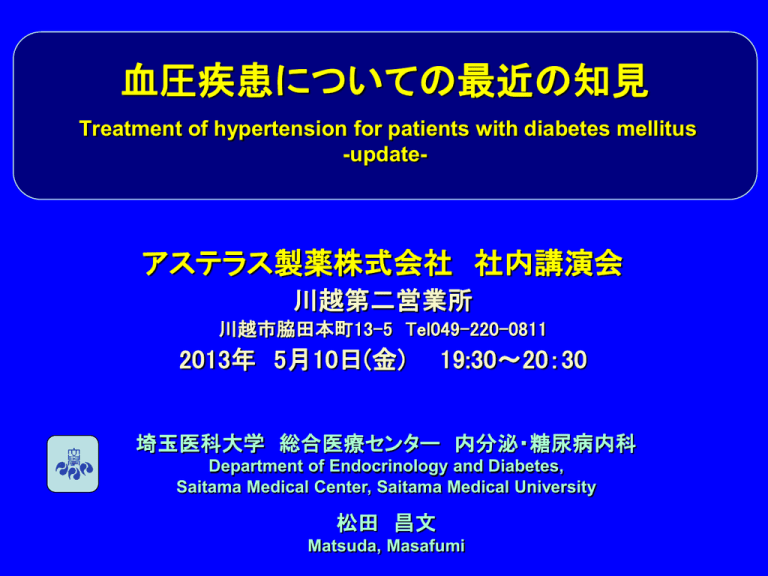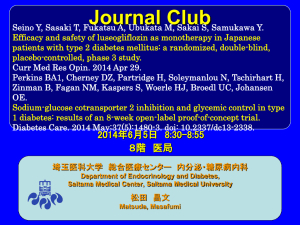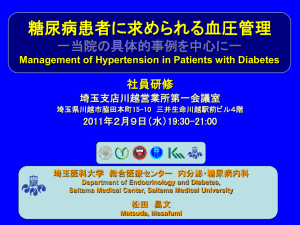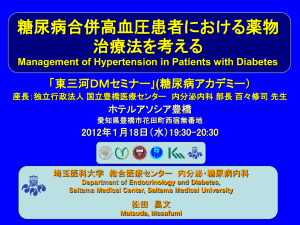
血圧疾患についての最近の知見
Treatment of hypertension for patients with diabetes mellitus
-update-
アステラス製薬株式会社 社内講演会
川越第二営業所
川越市脇田本町13-5 Tel049-220-0811
2013年 5月10日(金)
19:30~20:30
埼玉医科大学 総合医療センター 内分泌・糖尿病内科
Department of Endocrinology and Diabetes,
Saitama Medical Center, Saitama Medical University
松田 昌文
Matsuda, Masafumi
演者略歴
氏名: 松田昌文(まつだまさふみ)
研究分野: 内科学 内分泌 糖尿病代謝
インスリン作用 脳下垂体視床下部制御機構
略歴
1982年 東京大学医学部医学科卒業
1982年 東京大学医学部附属病院本院・分院研修
1987年 山口大学医学部講座助手(第3内科)
1988年 生山会斎木病院内科医師
1993年 Clinical Instructor, University of Texas
1994年 Instructor, University of Texas
1996年 Assistant Professor of Medicine, University of Texas
1997年 Diabetes Research Director, Texas Diabetes lnstitute (併任)
1999年 川崎医科大学医学部内科学(糖尿病部門)講師
2000年 川崎医科大学医学部内科学(内分泌糖尿病部門)講師
2006年 亀田総合病院糖尿病内分泌内科部長
2009年 埼玉医科大学総合医療センター内分泌・糖尿病内科教授
2010年 東京大学医学部糖尿病・代謝内科 非常勤講師
資格
米国Standard ECFMG certificate (USMLE Step 1,2,3合格)
医学博士
日本内科学会,日本糖尿病学会,日本内分泌学会 各学会専門医
業績 原著英文62,原著和文20など (インパクトファクター合計~280)
h-index 25
血圧疾患についての最近の知見
Treatment of hypertension for patients with diabetes mellitus
-update-
アステラス製薬株式会社 社内講演会
川越第二営業所
川越市脇田本町13-5 Tel049-220-0811
2013年 5月10日(金)
19:30~20:30
埼玉医科大学 総合医療センター 内分泌・糖尿病内科
Department of Endocrinology and Diabetes,
Saitama Medical Center, Saitama Medical University
松田 昌文
Matsuda, Masafumi
2012~2013年の動向
EASD/ADAの2型糖尿病治療ガイドライン(2012年)
五大疾病の1つとして地域医療計画の5年ごとの改訂
血糖介入 -
インスリン(ORIGIN研究、degludec)
インクレチン関連薬、SGLT-2阻害薬、チアゾリジン薬?
HbA1c:NGSP値使用
血糖介入目標 HbA1c
糖質制限の是非 と カーボカウント
血圧介入:
糖尿病透析予防指導
血圧ガイドライン、眠前服用、ARB、合剤
脂質介入:
脂質管理:LDL-C間接法、non-HDL-Cの使用
ニコチン製剤、ω3系、フィブラート系 評価
ブドウ糖とは?
ヒトの脳の唯一のエネルギー源
MANN, F. C., and MAGATH, T. B. (1922).-Arch. Intern. Moo. 30: 171.
検査値としての血糖は
plasma glucose: PG
(mg of glucose per dl
of plasma)で表記され
ます。
「糖尿病における食事療法の在り方と課題」 提言
1) 糖尿病における炭水化物摂取について
総エネルギー摂取量を制限せずに、炭水化物のみを
100g/日以下に制限することによって減量を図ることは、
その本来の効果のみならず、長期的な食事療法として
の遵守性や安全性など重要な点についてこれを担保す
るエビデンスが不足しており、現時点では薦められない。
2) 栄養素摂取比率について
糖尿病における三大栄養素の推奨摂取比率は、一般的
には、炭水化物50~60%(150g以上)、タンパク質20%以
下のこりを脂質(上限25%)とする。
わが国の2型糖尿病急増の背景
環境因子
遺伝因子
50年で脂肪
高脂肪食・運動不足
摂取量4倍
50年で4倍
2300万人
肥満・内臓脂肪蓄積
相互作用
膵臓
脂肪組織
骨格筋
糖
尿
病
患
者
数
増
加
率
肝臓
インスリン抵抗性
インスリン分泌低下
2210万人
インスリン作用不足
30
35倍
890万人
20
(欧米人の
約2分の1)
1620万人 1320 予
万人 備
1370万人
880
群
690
万人
2型糖尿病発症
万人
680
万人
10
740
万人
890 患
万人 者
1
0
55 60
70
80
90
02
08
1997
2002
2007
門脇 孝;日本臨牀,68,5,788, 2010.
埼玉県地域保健医療計画
第6次:平成25年度~29年度
2013.3.29 埼玉県HPより
第6節 糖尿病医療:埼玉県地域保健医療計画第6次
現状と課題
【予防・早期発見】
県民の糖尿病患者の死亡数は、平成23年は661人で、人口10万対の死亡率は9.3人と、
全国平均11.6人を下回っています。[平成23年人口動態統計(厚生労働省)]
糖尿病は、脳卒中、急性心筋梗塞等他疾患の危険因子となる慢性疾患であるとともに、多
種多様な合併症を引き起こすおそれのある疾患です。
糖尿病の発症に予防には代謝を促進し、内臓脂肪を減らすことが有効で、食生活の改善、
運動習慣の徹底、適正体重の維持が重要です。
糖尿病は、自覚症状がほとんどない病気のため、健康診査等を受診し肥満や高血糖など
危険因子の早期発見が大切です。
健康診査等により糖尿病が発見された場合は、適切に治療を行うことが必要です。
【糖尿病の治療・教育、合併症医療】
糖尿病の治療には、食事療法、運動療法、薬物療法による血糖値の管理及び血圧・脂質・
体重などの管理が行われます。これらの治療を身近な病院・診療所等の医師の管理の下、
継続的に行う必要があります。
糖尿病が進行すると合併症が発症してしまいます。糖尿病の主な合併症は、急性の糖尿病
性昏睡や慢性の腎症、網膜症、神経障害などです。
糖尿病や合併症の重症化を予防するため、病院と診療所との医療連携を基盤とする地域ぐ
るみの糖尿病診療体制の構築が必要です。
出典:2013.3.29 埼玉県地域保健医療計画
第6節 糖尿病医療:埼玉県地域保健医療計画第6次
課題の対応
①食生活・運動等に関する望ましい生活習慣の確立を図ります。
②医療保険者が行う特定健康診査・特定保健指導の活動を支援
します。
③医療機関の機能分化を進め、地域における医療連携体制の構
築を促進します。
出典:2013.3.29 埼玉県地域保健医療計画
第6節 糖尿病医療:埼玉県地域保健医療計画第6次
糖尿病における医療推進体制モデル
【糖尿病の治療・教育】
【予防・検診機能】
専門的な治療を行う医療機関
かかりつけ医
(診療所・病院)
紹介
◆血糖管理・
血圧管理
及びその教育
・食事療法
・運動療法
・薬物療法
紹介
相談
診療
健診・
検診
機関
【合併症の発症】
◆糖尿病性網膜症
◆糖尿病性腎症
◆糖尿病性神経障害
◆糖尿病性足病変
◆動脈硬化性疾患
◆歯周病 など
紹介
かかりつけ歯科医
連携
連携
(歯周病の管理)
在宅療養支援病院
連携
在宅療養支援診療所
在宅療養支援歯科診療所
訪問看護
ステーション
連携
かかりつけ医
連携
連携
かかりつけ薬局
(診療所・病院)
生活の場(在宅医療)
連携
(薬剤師)
介護事業者
訪問薬剤管理指導
医療機器の提供・j管理
(有料医療老人ホーム、ケアハウスなど多様な居住の場を含む)
出典:2013.3.29 埼玉県地域保健医療計画
チーム医療
医師(5年以上の指導経験)
看護師(療養指導士)
管理栄養士(療養指導士)
埼玉医科大学総合医療センター 内分泌・糖尿病内科
2013 Clinical Practice Recommendations
•The position statement “Diagnosis and
Classification of Diabetes Mellitus” has
been revised slightly to add newer
information about monogenic forms of
diabetes.
Diabetes Care. 2013 Jan;36(suppl 1):s1-s99.
•Section II.C. Screening for Type 1 Diabetes has been revised to include more specific
recommendations.
•Section IV. Prevention/Delay of Type 2 Diabetes has been revised to reflect the importance of
screening for and treating other cardiovascular risk factors.
•Section V.C.a. Glucose Monitoring has been revised to highlight the need for patients on intensive
insulin regimens to do frequent self-monitoring of blood glucose.
•Section V.D. Pharmacological and Overall Approaches to Treatment has been revised to add a
section with more specific recommendations for insulin therapy in type 1 diabetes.
•Section V.F. Diabetes Self-Management Education and Support has been revised to be consistent
with the newly revised National Standards for Diabetes Self-Management Education and Support.
•Section V.K. Hypoglycemia has been revised to emphasize the need to assess hypoglycemia and
cognitive function when indicated.
•Section V.M. Immunization has been updated to include the new Centers for Disease Control and
Prevention (CDC) recommendations for hepatitis B vaccination for people with diabetes.
•Section VI.A.1. Hypertension/Blood Pressure Control has been revised to suggest that the
systolic blood pressure goal for many people with diabetes and hypertension should be <140
mmHg, but that lower systolic targets (such as <130 mmHg) may be appropriate for certain
individuals, such as younger patients, if it can be achieved without undue treatment burden.
•Section VI.A.2. Dyslipidemia/Lipid Management and Table 10 have been revised to emphasize the
importance of statin therapy over particular LDL cholesterol goals in high-risk patients.
•Section VI.B. Nephropathy Screening and Treatment and Table 11 have been revised to highlight
increased urinary albumin excretion over the terms micro- and macroalbuminuria, other than when
discussion of past studies requires the distinction.
•Section VI.C. Retinopathy Screening and Treatment has been revised to include anti–vascular
endothelial growth factor therapy for diabetic macular edema.
•Section IX.A. Diabetes Care in the Hospital has been revised to include a recommendation to
consider obtaining an A1C in patients with risk factors for undiagnosed diabetes who exhibit
hyperglycemia in the hospital.
Message
米国糖尿病診療の改正ポイント
1. SMBGの記載が若干変更された。
2. B型肝炎ワクチン接種の推奨
3. 血圧管理について変更あり。140/80mmHg!
4. LDL-Cの重要性!
スタチン以外の併用は推奨せず
5. 低血糖への対応の記載が強化
6. CKD対応にともなう記載の強化
7. 眼科治療で抗VEGF治療の記載が追加
8. 糖尿病のリスクとして「鬱」が追加
9. Monogenic forms of diabetes (neonatal diabetes or
maturity-onset diabetes of the young) が記載
10.糖尿病リスクがある場合の記述の追加
EASD/ADAの有識者が推奨して
いる2型糖尿病治療のガイドライ
ンが改訂されました。
“Patient-Centered Approach”
「個々の患者の噌好、ニーズ、価値観に敬意を払い
かつそれらに対応したケアを提供する」
「患者の価値が全ての臨床的な意思決定を
誘導することを保証する」
●患者がどの程度の関与を望むのかを計る
●意思決定を共有する一ライフスタイルの選択などの
最終決定は患者側に寄り添う
●可能な治療選択肢を探求する
Diabetologia 55:1577-96, 2012, Diabetes Care 35:1364-1379, 2012
血圧管理について
Ann Intern Med. 2003;138:593-602
Suppression of RAS
Suppression of renin-angiotensin system is
alternative way to improve insulin sensitivity,
and ARB or ACEI is a choice of medication
in T2DM patients with hypertension.
Intervention
to Overcome Insulin Resistance
DeFronzo RA. From the triumvirate to the
ominous octet: a new paradigm for the
treatment of type 2 diabetes mellitus
[Banting Lecture]. Diabetes. 2009;58:773-795.
Diagram of AⅡ signaling interactions with the insulin
receptor, IRS-1, and PI 3 kinase in RASMC
AⅡ
PI 3-kinase
P-Ser-
-Tyr-P
-Tyr-P
β
-Tyr-P
-Tyr-P
-Tyr-P
α
P-Ser-
Insulin
Receptor
P85
IRS-1
Folli et al: J. Clin. Invest. 100:2158–2169, 1997
P110
Insulin sensitivity after administration of ACE-I,
CaCB, and alpha AB
Insulin-medicated
glucose uptake,
glucose oxidation, and
non-oxidative glucose
disposal during the
euglycemic clamp
before (open bars) and
after (solid bars) 3
months of treatment
with doxazossin.
Giordano M, Matsuda M, Sanders L, Canessa ML, DeFronzo RA.: Effects of angiotensin-converting enzyme
inhibitors, Ca2+ channel antagonists, and alpha-adrenergic blockers on glucose and lipid metabolism in
NIDDM patients with hypertension. Diabetes. 1995 Jun;44(6):665-71.
Prevention of Diabetes Mellitus
follow-up,
year
drug
No. of new
on-set of DM
No.(total)
event
per 1000
person-years
control
antihypertensive drug
1999
CAPPP
6.1
ACEI
337
5183
10.7
β blocker
380
5230
11.9
1960
12.4
4.0
ACEI
93
1970
11.8
β blocker
Diuretic
CCB
97
STOP-2
95
1935
12.1
Trial
publication
1999
No. of new
No.(total)
on-set of DM
event
per 1000
person-years
HOPE
2001
4.5
ACEI
102
2837
8.0
Placebo
155
2883
11.9
ALLHAT
2002
4.0
ACE
119
4096
7.3
CCB
Diuretic
154
302
3954
6766
9.7
11.2
PEACE
ANBP-2
2004
4.8
ACEI
335
3432
20.3
Placebo
399
3472
23.9
2005
4.1
ACEI
138
2800
12.0
Diuretic
200
2826
17.3
AASK
2006
3.8
ACEI
45
410
28.9
β blocker
CCB
70
32
405
202
45.5
41.7
*DREAM
LIFE
*ALPINE
CHARM
SCOPE
VALUE
CASE-J
*ProFESS
*ONTARGET
2006
3.0
ACEI
449
2623
57.1
Placebo
489
2646
61.6
2002
4.8
ARB
242
4020
12.5
β blocker
320
3979
16.8
2003
1.0
ARB
1
196
5.1
Diuretic
8
196
40.8
2003
3.1
ARB
163
2715
19.4
Placebo
202
2721
23.9
2003
3.7
ARB
93
2167
11.6
Placebo
115
2175
14.3
2004
4.2
ARB
690
5087
32.3
CCB
845
5074
39.7
2007
3.2
ARB
38
1343
8.8
CCB
59
1342
13.7
2008
2.5
ARB
125
7306
6.8
Placebo
151
7283
8.3
2008
4.7
ARB
399
8542
10.0
ACEI
366
8576
9.2
*ONTARGET
2008
4.7
ARB
+ACEI
323
8502
8.1
ACEI
366
8576
9.2
*TRANSCEND
*HIJ-CREATE
*Kyoto Heart
*NAVIGATOR
2008
4.7
ARB
319
2954
26.4
Placebo
395
2972
28.8
2009
4.2
ARB
7
645
2.6
Placebo
18
624
6.9
2009
3.27
ARB+X
58
1116
51.6
X
86
998
76.7
2010
6.5
ARB
1532
3748
62.9
Placebo
1722
3725
71.1
Matsuda M.; Endocrinology&Diabetology;26,1,35-41,2008.
糖尿病を合併する高血圧の治療計画
治療開始血圧 130/80mmHg以上
生活習慣の修正・血糖管理と同時に薬物療法*
第一選択薬:ACE阻害薬、ARB
効果不十分
用量を増加
Ca拮抗薬、利尿薬を併用
効果不十分
3剤併用:ARBあるいはACE阻害薬、Ca拮抗薬、利尿薬
降圧目標 130/80mmHg未満
* 血圧が130-139/80-89mmHgで生活習慣の修正で降圧目標が見込める場合は、
3か月を超えない範囲で生活習慣の修正により降圧を図る
高血圧治療ガイドライン2009.
食事療法
Guidelines for Secondary Prevention of Myocardial Infarction( JCS 2011)
ACEIと利尿薬の併用が
尿アルブミン減少に有利
The primary end point
was the composite of
death from
cardiovascular
causes, nonfatal
myocardial infarction,
nonfatal stroke,
hospitalization for
angina, resuscitation
after sudden cardiac
arrest, and coronary
revascularization.
ACEIとCa拮抗薬の併用が
心血管イベント抑制には有利
N Engl J Med 2008;359:2417-28.
2013 Clinical Practice Recommendations
•The position statement “Diagnosis and
Classification of Diabetes Mellitus” has
been revised slightly to add newer
information about monogenic forms of
diabetes.
Diabetes Care. 2013 Jan;36(suppl 1):s1-s99.
•Section II.C. Screening for Type 1 Diabetes has been revised to include more specific
recommendations.
•Section IV. Prevention/Delay of Type 2 Diabetes has been revised to reflect the importance of
screening for and treating other cardiovascular risk factors.
•Section V.C.a. Glucose Monitoring has been revised to highlight the need for patients on intensive
insulin regimens to do frequent self-monitoring of blood glucose.
•Section V.D. Pharmacological and Overall Approaches to Treatment has been revised to add a
section with more specific recommendations for insulin therapy in type 1 diabetes.
•Section V.F. Diabetes Self-Management Education and Support has been revised to be consistent
with the newly revised National Standards for Diabetes Self-Management Education and Support.
•Section V.K. Hypoglycemia has been revised to emphasize the need to assess hypoglycemia and
cognitive function when indicated.
•Section V.M. Immunization has been updated to include the new Centers for Disease Control and
Prevention (CDC) recommendations for hepatitis B vaccination for people with diabetes.
•Section VI.A.1. Hypertension/Blood Pressure Control has been revised to suggest that the systolic
blood pressure goal for many people with diabetes and hypertension should be <140 mmHg, but
that lower systolic targets (such as <130 mmHg) may be appropriate for certain individuals, such
as younger patients, if it can be achieved without undue treatment burden.
•Section VI.A.2. Dyslipidemia/Lipid Management and Table 10 have been revised to emphasize the
importance of statin therapy over particular LDL cholesterol goals in high-risk patients.
•Section VI.B. Nephropathy Screening and Treatment and Table 11 have been revised to highlight
increased urinary albumin excretion over the terms micro- and macroalbuminuria, other than when
discussion of past studies requires the distinction.
•Section VI.C. Retinopathy Screening and Treatment has been revised to include anti–vascular
endothelial growth factor therapy for diabetic macular edema.
•Section IX.A. Diabetes Care in the Hospital has been revised to include a recommendation to
consider obtaining an A1C in patients with risk factors for undiagnosed diabetes who exhibit
hyperglycemia in the hospital.
Testing for diabetes in asymptomatic patients
Hypertension/blood pressure control
Screening and diagnosis
DIABETES CARE, VOLUME 36, SUPPLEMENT 1, JANUARY 2013
Blood pressure should be measured at every routine visit. Patients found to have elevated blood
pressure should have blood pressure confirmed on a separate day. (B)
Goals
People with diabetes and hypertension should be treated to a systolic blood pressure goal of <140
mmHg. (B)
Lower systolic targets, such as <130 mmHg, may be appropriate for certain individuals, such as
younger patients, if it can be achieved without undue treatment burden. (C)
Patients with diabetes should be treated to a diastolic blood pressure <80 mmHg. (B)
Treatment
Patients with a blood pressure >120/80 mmHg should be advised on lifestyle changes to reduce blood
pressure. (B)
Patients with confirmed blood pressure ≥140/80 mmHg should, in addition to lifestyle therapy, have
prompt initiation and timely subsequent titration of pharmacological therapy to achieve blood
pressure goals. (B)
Lifestyle therapy for elevated blood pressure consists of weight loss, if overweight; Dietary
Approaches to Stop Hypertension (DASH)-style dietary pattern including reducing sodium and
increasing potassium intake; moderation of alcohol intake; and increased physical activity. (B)
Pharmacological therapy for patients with diabetes and hypertension should be with a regimen that
includes either an ACE inhibitor or an angiotensin receptor blocker (ARB). If one class is not tolerated,
the other should be substituted. (C)
Multiple-drug therapy (two or more agents at maximal doses) is generally required to achieve blood
pressure targets. (B)
Administer one or more antihypertensive medications at bedtime. (A)
If ACE inhibitors, ARBs, or diuretics are used, serum creatinine/estimated glomerular filtration rate
(eGFR) and serum potassium levels should be monitored. (E)
In pregnant patients with diabetes and chronic hypertension, blood pressure target goals of 110–
129/65–79 mmHg are suggested in the interest of long-term maternal health and minimizing impaired
fetal growth. ACE inhibitors and ARBs are contraindicated during pregnancy. (E)
降圧薬眠前服用の効果
Hazard ratios (95% CIs) of CVD events (adjusted
by age and sex) as a function of time of day of
hypertension treatment, i.e., for patients with type
2 diabetes ingesting either all their blood
pressure–lowering medications upon awakening
or ≧1 medications at bedtime. Total events
include death (from all causes), cardiovascular
events (myocardial infarction, angina pectoris,
and coronary revascularization), cerebrovascular
events (stroke and transient ischemic attack),
heart failure, and other events (acute arterial
occlusion of lower extremities and thrombotic
occlusion of the retinal artery). Major events
include cardiovascular deaths, myocardial
infarction, ischemic stroke, and hemorrhagic
stroke.
Kaplan-Meier survival curves as a function of time of
day of hypertension treatment, i.e., for patients with
type 2 diabetes ingesting either all their blood
pressure–lowering medications upon awakening or
≧1 medications at bedtime.
Hermida RC, Ayala DE, Mojón A, Fernández JR. Influence of time of day of blood pressurelowering treatment on cardiovascular risk in hypertensive patients with type 2 diabetes. Diabetes
Care 2011;34:1270–1276
Randomized Olmesartan and Diabetes Microalbuminuria Prevention (ROADMAP) study
From the Department of Nephrology and Hypertension, Hannover Medical School, Hannover (H.H., J.M.); the Department of
Nephrology, University of Heidelberg, Heidelberg (E.R.); and the Department of Nephrology, Heinrich- Heine-University Düsseldorf
(L.C.R.) — all in Germany; the Department of Clinical Medicine, Division of Nephrology, Endocrinology, and Vascular Medicine,
Tohoku University Graduate School of Medicine, Sendai (S.I.); and the Department of Endocrinology and Diabetes, Saitama Medical
School, Iruma, Saitama (S.K.) — both in Japan; the Department of Medicine, School of Medicine and Biomedical Sciences, State
University of New York at Buffalo, Buffalo ( J.L.I.); the Institute of Cardiology, Department of Hypertension, Warsaw, Poland (A.J.);
Hospital Lapeyronie, Montpellier, France (A.M.); the Department of Nephrology and Einthoven Laboratory for Vascular Medicine,
Leiden University Medical Center, Leiden, the Netherlands (T.J.R.); the Division of Hypertension, Hospital 12 de Octubre, Madrid
(L.M.R.); and King’s College London School of Medicine, Guy’s Hospital, London (G.V.).
N Engl J Med 2011;364:829-41.
23%のリスク減少
微
量
ア
ル
ブ
ミ
ン
尿
川越市広報室撮影
2009年11月14日
2009年度
2010年度
Sulfonylureas
Metformin
DPP-4 inhbitor
Thiazolidinedione
alpha-glucosidase inhibitor
Glinide
Oral hypoglycemic agents use
2011年度
2012年度
1160
879
949
608
1535
1155
1210
884
22
541
990
1296
528
433
352
405
688
376
284
379
360
156
177
209
2100
1892
1751
1678
埼玉医科大学総合医療センター内分泌・糖尿病内科
2012年度
糖尿病患者
2153
1689
942
182
経口血糖降下薬
インスリン
GLP-1受容体作動薬
経口血糖降下薬
例数
平均投与量
(mg)
アクトス
18.2
メトグルコ
1149.6
グルコバイ
254.1
ボグリボース
0.7
セイブル
162.3
アマリール
1.2
グリミクロン
63.4
グルファスト
29.3
ファスティック
213.5
シュアポスト
1.3
ジャヌビア
63.0
エクア
94.5
ネシーナ
20.7
トラゼンタ
5.0
100%
78.4%
43.8%
8.5%
割合
平均年齢
(最後処方者に対し)
SU薬
メトホルミン
インクレチン薬
チアゾリジン薬
αグルコシダーゼ阻害薬
グリニド薬
608
884
1296
405
379
209
36.0%
52.3%
76.7%
24.0%
22.4%
12.4%
64.7
61.0
64.5
64.3
65.0
65.6
インスリン
速効型・超速効型
混合型
中間型・持効型
バイアル製剤(CSII)
cf.CSII実施者は12名
割合(最後処方者に対し)
例数
733
77.8%
140
14.9%
744
79.0%
12
1.3%
GLP-1受容体作動薬
ビクトーザ
バイエッタ
例数
割合(最後処方者に対し)
96
97
52.7%
53.3%
2011年度
2012年度
GLP-1受容体 2010年度
作動薬
処方数
処方数
処方数
ビクトーザ
114 (94.2%) 152 (77.9%)
96 (49.7%)
バイエッタ
合計症例
7 (5.8%)
121
43 (22.1%)
195
97 (50.3%)
193
埼玉医科大学総合医療センター内分泌・糖尿病内科
Metforminの用量(mg/日)の推移
350
amaryl 232, generic 279 in 2012
1.95±1.32 mg/day in 2009 (n=879)
300
1.18±0.98 mg/day in 2012 (n=511)
250
処方症例数
処方症例数
Glimepirideの用量(mg/日)の推移
1200
693±179 mg/day in 2009 (n=1535)
1100±555 mg/day in 2012 (n=882)
1000
800
200
600
150
400
100
200
50
0
0
0.5
2009 117
2012 191
125 250 500 750
1
1.5
2
2.5
3
4
6
287
5
235
1
108
95
31
2009年度
204
1
80
13
14
8
2012年度
2
100 150 175 200 225
0
0
0
0
0
53
348 1083 18
31
28
175 159 199 209
1
28
83
埼玉医科大学総合医療センター内分泌・糖尿病内科
(%)
45
40
Glimepirideの用量(mg/日)の推移
amaryl 232, generic 279 in 2012
(%) Metforminの用量(mg/日)の推移
80
693±179 mg/day in 2009 (n=1535)
1100±555 mg/day in 2012 (n=882)
1.95±1.32 mg/day in 2009 (n=879)
1.18±0.98 mg/day in 2012 (n=511)
70
2009年度
35
2012年度
2009年度
60
2012年度
30
50
25
40
20
15
30
10
20
5
10
0
0.5 1 1.5 2 2.5 3
4
6
0
125
250
500
750 1000 1500 1750 2000 2250
埼玉医科大学総合医療センター内分泌・糖尿病内科
平均処方mg数
降圧薬
例数
dose1,
dose1,
dose1,
dose1,
dose1,
dose1,
合計
abB
ACEI
ARB
CaB
DiU
1889
185
81
838
523
262
dose1,
dose1,
dose1,
dose1,
dose1,
dose1,
dose1,
dose1,
dose1,
dose1,
dose1,
dose1,
dose1,
dose1,
dose1,
dose1,
dose1,
dose1,
dose1,
dose1,
dose1,
dose1,
dose1,
dose1,
dose1,
dose1,
dose1,
dose1,
dose1,
dose1,
dose1,
dose1,
dose1,
dose1,
dose1,
dose1,
dose1,
合計
abB, 11
abB, 21
abB, 22
abB, 23
abB, 24
abB, 25
abB, 31
ACEI, 1
ACEI, 2
ACEI, 3
ACEI, 4
ACEI, 6
ACEI, 7
ARB, 11
ARB, 12
ARB, 13
ARB, 14
ARB, 15
ARB, 16
ARB, 31
CaB, 11
CaB, 12
CaB, 13
CaB, 14
CaB, 15
CaB, 16
CaB, 18
CaB, 19
CaB, 20
DiU, 1
DiU, 2
DiU, 3
DiU, 4
DiU, 5
DiU, 6
DiU, 8
平均
25.565
1.829
10
36.63
3
6.053
20
181.818
2
2
4.609
5
1
12.5
7.306
19.679
89.412
42.646
39.563
100
150
16
10
20
23.889
4.527
2
20
88.333
4
1.13
2
24.615
50
4
24.646
30
±
±
±
±
±
±
±
±
±
±
±
±
±
±
±
±
±
±
±
±
±
±
±
±
±
±
±
±
±
±
±
±
±
±
±
±
±
標準偏差 例数
31.931
1889
0.381
41
0
54
12.998
46
1.054
10
3.847
19
0
4
65.279
11
0
10
0
4
0.922
32
0
29
.
1
0
5
1.839
121
4.341
249
34.162
136
17.24
189
12.389
103
0
30
0
10
0
29
0
94
0
19
8.028
36
1.192
328
0
2
.
1
28.577
6
0
8
0.339
92
0
13
2.402
39
0
6
0
5
8.489
99
0
8
合剤
平均
標準偏差 例数
平均処方mg数 TDOSE1,
TDOSE1,
TDOSE1,
TDOSE1,
TDOSE1,
TDOSE1,
TDOSE1,
TDOSE1,
TDOSE1,
9901
9902
9903
9904
9905
9906
9907
9908
9911
8
20
80
80
80
50
40
8
5
±
±
±
±
±
±
±
±
±
0
0
0
0
0
0
0
0
0
8
13
8
14
11
27
31
8
8
TDOSE2,
TDOSE2,
TDOSE2,
TDOSE2,
TDOSE2,
TDOSE2,
TDOSE2,
TDOSE2,
TDOSE2,
9901
9902
9903
9904
9905
9906
9907
9908
9911
6.25
16
7.031
5
12.5
12.5
5
4.375
8.75
±
±
±
±
±
±
±
±
±
0
0
2.21
0
0
0
0
1.157
2.315
8
13
8
14
11
27
31
8
8
2012年11月14日
埼玉りそな銀行川越支店 国・登録有形文化財
大宮ソニックシティビル



